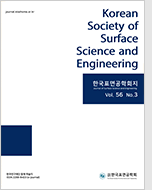
- Past Issues
- e-Submission
-

2021 Impact Factor 1.766
5-Year Impact Factor 1.674
Editorial Office
- +82-2-563-0935
- +82-2-558-2230
- submission@kssse.or.kr
- https://www.kssse.or.kr/

2021 Impact Factor 1.766
5-Year Impact Factor 1.674
The Korean Society of Surface Science and Engineering 2023;56(6):420-426. Published online: Dec, 28, 2023
DOI : 10.5695/JSSE.2023.56.6.420
We prepared a highly sensitive hydrogen (H2) sensor based on Indium oxides (In2O3) porous nanoparticles (NPs) loaded with Platinum (Pt) nanoparticle in the range of 1.6~5.7 at.%. In2O3 NPs were fabricated by microwave irradiation method, and decorations of Pt nanoparticles were performed by electroless plating on In2O3 NPs. Crystal structures, morphologies, and chemical information on Pt-loaded In2O3 NPs were characterized by grazing-incident X-ray diffraction, field-emission scanning electron microscopy, energy-dispersive X-ray spectroscopy, respectively. The effect of the Pt nanoparticles on the H2-sensing performance of In2O3 NPs was investigated over a low concentration range of 5 ppm of H2 at 150–300 °C working temperatures. The results showed that the H2 response greatly increased with decreasing sensing temperature. The H2 response of Pt loaded porous In2O3 NPs is higher than that of pristine In2O3 NPs. H2 gas selectivity and high sensitivity was explained by the extension of the electron depletion layer and catalytic effect. Pt loaded porous In2O3 NPs sensor can be a robust manner for achieving enhanced gas selectivity and sensitivity for the detection of H2.
Keywords Gas sensor, Hydrogen, fast recovery, In2O3 , microwave irradiation method, Platinum